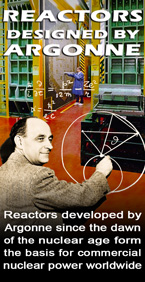Facilities
NE has world-class facilities where scientists and engineers perform cutting-edge research.
- Aerosol Lab

- The Aerosol Lab (AL) houses equipment to measure and record the physical parameters necessary to characterize the formation and transport of aerosols… [more about the Aerosol Lab]
- ALEX (Argonne Liquid metal EXperiment)
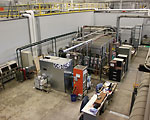
- The ALEX (Argonne Liquid metal EXperiment) facility is designed to house liquid metal systems for experimental research in various areas including, but not limited to, nuclear physics, material science, and nuclear engineering… [more about ALEX]
- Analytical Chemistry Laboratory

- The Analytical Chemistry Laboratory provides analytical chemistry support services to the scientific and engineering programs at Argonne National Laboratory and specialized analysis for others.… [more about the Analytical Chemistry Laboratory]
- Computer Facilities (CF)

- State-of-the-art equipment provided to in-house staff and collaborating scientists. We have a two HPC clusters (256 and 368 cores) as an advanced computational platform for performing a variety of engineering analyses. We also use facilities outside the Division such as Blues, a terascale (107.8 TFlops) Linux computing cluster with 310 nodes, and the CAVE, one of the four sophisticated automatic virtual environment systems in existence … [more about Computer Facilities]
- Environmentally Assisted Cracking (EAC) Laboratory

- Four autoclave systems used to evaluate the resistance of nuclear reactor structural materials environmentally assisted cracking in simulated LWR coolant environments… [more about the EAC facilities]
- High Temperature Corrosion Test Facilities and High Pressure Test Facilities for Metal Dusting
-

- Six corrosion test facilities and two thermogravimetric systems for conducting corrosion tests in complex mixed gas environments, in steam and in the presence of deposits, and five facilities for metal dusting degradation… [more about the EAC facilities]
- Intermediate Voltage Electron Microscopy (IVEM)-Tandem
-

- The IVEM-Tandem User Facility features TEM with In situ ion irradiation for research on advanced materials for nuclear systems: structural alloys, fuels, and complex oxides.… [more about the Intermediate Voltage Electron Microscopy (IVEM)-Tandem User Facility]
- Irradiated Materials Laboratory (IML)
-
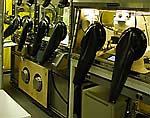
- Used to conduct research on the behavior of commercial nuclear reactor materials, including fuel cladding, pressure vessel steels, and other in-reactor components. The four beta-gamma hot cells and the glove boxes are used to determine mechanical properties of these materials and degradation due to long-time operation in corrosive and irradiation environments. Loss-of coolant accident environment is also simulated to allow determination of post-quench ductility… [more about the Irradiated Materials Laboratory]
- Low-Energy Accelerator Facility (LEAF)
-

- Argonne National Laboratory’s 50 MeV/25 kW electron linear accelerator can produce a wide range of useful radioisotopes for medical, national security, basic science and industrial applications..… [more about LEAF]
- Mechanisms Engineering Test Loop Facility (METL)
-
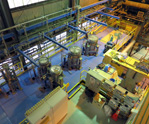
- The Mechanisms Engineering Test Loop (METL) facility, established in 2010, is an intermediate-scale liquid metal experimental facility that provides purified R-grade sodium to various experimental test vessels to test components that are required to operate in a prototypical advanced reactor environment. [more about METL]
- Natural Convection Shutdown Heat Removal Test Facility (NSTF)
-
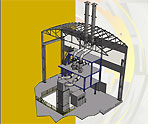
- Argonne National Laboratory’s Natural Convection Shutdown Heat Removal Test Facility (NSTF) provides confirmatory data for passive safety systems and decay heat removal in advanced nuclear reactor designs.… [more about the NSTF]
- Non-destructive Evaluation (NDE) and Testing Facilities
-

- The Non-destructive Evaluation (NDE) and Testing Facilities contain state-of-the-art NDE laboratories including microwave/millimeter wave, acoustic/ultrasonic, X-ray, thermal imaging, optics, and eddy current for health monitoring of materials and components used in aerospace, defense, and power generation (fossil and nuclear) industries as well as for medical and scientific research… [more about the NDE Facilities]
- Reactor Safety Experimentation
-
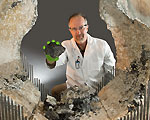
- Our corium/concrete interaction experiments, the largest of their kind, support development of severe accident codes. Two fluid dynamics facilities provide benchmark data for CFD codes and a liquid sodium rig examines sodium/CO2 interactions for advanced energy conversion applications… [more about Reactor Safety Experimentation]
- Remote Handling Mockup Facility
-

- Argonne's Remote Handling Mockup Facility simulates the handling of radioactive materials in a non-radioactive environment… [more about the Remote Handling Mockup facility]
- Steam Generator Tube Integrity Facilities
-

- The facilities include the High Temperature Blowdown Facility, the Room Temperature High Pressure Facility, the Tube/Tube-sheet Severe Accident Leakage Facility, and the Model Boiler Facility… [more about the Steam Generator Tube Integrity Facilities]
- Transmission Electron Microscope and Scanning Electron Microscopes
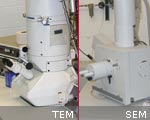
- The research activities of the Corrosion and Mechanics of Materials Section are supported by complete metallography/sample preparation rooms equipped with several optical and electron microscopes: a Transmission Electron Microscope (TEM) and two Scanning Electron Microscopes (SEMs)… [more about the Transmission Electron Microscope and Scanning Electron Microscopes]
- eXtreme MATerials beamline (XMAT)
-
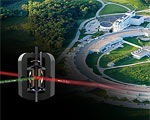
- XMAT is a proposed extreme materials beamline for the Advanced Photon Source Upgrade aimed at developing new and more capable radiation tolerant materials for nuclear environments.
By applying APS hard x-ray analysis techniques to materials samples under energetic (MeV/nucleon) heavy ion irradiation, XMAT enables in-situ examination of irradiation effects in materials where the major experimental variables (e.g., temperature, applied load, and irradiation levels) are well controlled. The penetrating ability and accelerated dose impartation of energetic ions and the high spatial and temporal resolution afforded by APS x-rays combine to allow unprecedented in situ observation of radiation bulk damage in real time… [more about XMAT]
Last Modified: Thu, February 13, 2020 4:55 PM


